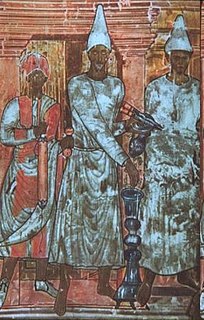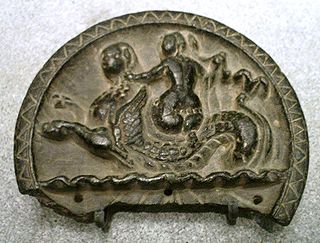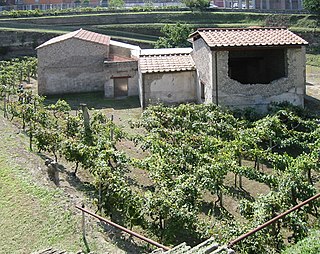 W
WHellenistic art is the art of the Hellenistic period generally taken to begin with the death of Alexander the Great in 323 BC and end with the conquest of the Greek world by the Romans, a process well underway by 146 BCE, when the Greek mainland was taken, and essentially ending in 30 BCE with the conquest of Ptolemaic Egypt following the Battle of Actium. A number of the best-known works of Greek sculpture belong to this period, including Laocoön and His Sons, Venus de Milo, and the Winged Victory of Samothrace. It follows the period of Classical Greek art, while the succeeding Greco-Roman art was very largely a continuation of Hellenistic trends.
 W
WThe Alexander Mosaic is a Roman floor mosaic originally from the House of the Faun in Pompeii that dates from circa 100 BC. It is typically dated in the second half of the century between 120 and 100 B.C. It depicts a battle between the armies of Alexander the Great and Darius III of Persia and measures 2.72 by 5.13 metres. This work of art is a combination of different artistic traditions such as Italic, Hellenistic, and Roman. The mosaic is considered “Roman” based on the broader context of its time and location in relation to the later Roman Republic. The original is preserved in the Naples National Archaeological Museum. The mosaic is believed to be a copy of an early 3rd-century BC Hellenistic painting.
 W
WIn Greek mythology, Amazonomachy was one of various mythical battles between the ancient Greeks and the Amazons, a nation of all-female warriors. Many of the myths portrayed were that of Heracles' ninth labor, which was the retrieval of the girdle of Hippolyta, Queen of the Amazons, and of Theseus' abduction of Hippolyta, whom he claimed as his wife -- which led to the Attic War. Another famous scene portrayed is that of Achilles' victorious battle against Penthesilea during the Trojan war.
 W
WThe Beauty of Durrës is a polychromatic mosaic of the 4th century BC and is the most ancient and important mosaic discovered in Albania. The 9 m2 (97 sq ft) mosaic is elliptical in shape and depicts a woman’s head on a black background, surrounded by flowers and other floral elements. It was discovered in 1918 in Durrës, and since 1982 has been on display at the National Historical Museum of Albania in Tirana.
 W
WThe Bema of Phaidros is the marble platform created in the third century CE that served as stage front to the Theatre of Dionysos Athens. It is decorated with a Neo-Attic Roman sculpture of the Hadrianic or Antonine period, this sculpture was dismantled sometime in antiquity, moved from an unknown location, and rebuilt into the Bema of the Theatre by Phaidros, archon of Athens. Four stone reliefs decorate the stage front illustrating scenes from the life of Dionysos they are: 1) The birth of Dionysos, 2) the entrance of Dionysos into Attica, 3) the sacred marriage of Dionysos and the Basilinna and 4) the enthronement of Dionysos. These scenes are framed by crouching silenoi.
 W
WThe Cup of the Ptolemies, also known as the Cup of Saint Denis, is an onyx cameo two-handled cup, or kantharos. The cup, decorated with Dionysiac vignettes and emblems, was carved at some point in Classical Antiquity, probably in Alexandria. Eventually, it found its way into the treasury of the French kingdom, before it was donated to the abbey of St. Denis. During the Middle Ages, it was used as a Christian chalice, and lavish mounts were added, with Latin inscriptions. In 1804, the cup was stolen, and the mounts were lost, although the cup itself was recovered. It is now in the Cabinet des Médailles at the Bibliothèque Nationale de France, Paris.
 W
WThe Derveni Krater is a volute krater, the most elaborate of its type, discovered in 1962 in a tomb at Derveni, not far from Thessaloniki, and displayed at the Archaeological Museum of Thessaloniki. Weighing 40 kg, it is made of a bronze with a high tin content of about 15%, which endows it with a superb golden sheen without use of any gold at all. It is dated to the 4th century BC, and was probably made in Athens. Large metalwork vessels are extremely rare survivals in Ancient Greek art, and the Derveni Krater is the outstanding survival from Hellenistic art, as the Vix Krater is from the Archaic period.
 W
WMummy portraits or Fayum mummy portraits are a type of naturalistic painted portrait on wooden boards attached to upper class mummies from Roman Egypt. They belong to the tradition of panel painting, one of the most highly regarded forms of art in the Classical world. The Fayum portraits are the only large body of art from that tradition to have survived. They were formerly, and incorrectly, called Coptic portraits.
 W
WThe Gonzaga Cameo is a Hellenistic engraved gem; a cameo of the capita jugata variety cut out from the three layers of an Indian sardonyx, dating from perhaps the 3rd century BC. It was a centrepiece of the Gonzaga collection of antiquities, first described in a 1542 inventory of Isabella d'Este's collection as representing Augustus and Livia. The figures were later identified as Alexander the Great and Olympias, Germanicus and Agrippina the Elder, Nero and Agrippina the Younger, and many other famous couples of antiquity. The male figure on the cameo is clad in the attributes of Alexander, including a laurel-wreathed helmet, and wears a gorgoneion. His other aegis represents a bearded head, probably that of Zeus Ammon. The man's laurel wreath is crowned by a snake which suggests the uraeus. The contrasting male and female profiles were in all probability intended to suggest Zeus and Hera. The brown necklace is a later addition masking that the cameo was, at some point, broken in half.
 W
WGreco-Buddhist art is the artistic manifestation of Greco-Buddhism, a cultural syncretism between the Classical Greek architecture and Buddhism. Greco-Buddhist art is characterized by the strong idealistic realism and sensuous description of Hellenistic art and it is believed to be the first representations of the Buddha in human form.
 W
WHellenistic glass was glass produced during the Hellenistic period, from the conquests of Alexander the Great to the expansion of the Roman Empire in the Mediterranean, Europe, western Asia and northern Africa. Glassmaking at this time was based on the technological traditions of the Classical antiquity and the Late Bronze Age, but was marked by transition from limited production of luxury objects made for the social elite to mass production of affordable glass vessels used by the broader public to satisfy everyday needs.
 W
WIn the ancient Greek city of Demetrias in Thessaly, funerary stelai showed an assortment of mythological scenes, battle scenes, and more, all using the art styles of the Hellenistic period. Stelai in Ancient Greece were used almost in the same manner as modern tombstones, commemorating the dead. They were made of stone or marble, mainly. They often either showed scenes from the deceased's life, or a mythological scene. The use of stelai in Ancient Greece have been observed dating back to the bronze age.
 W
WThe Mathura Herakles is a famous statue found in the city of Mathura, India, thought to represent the Greek hero Herakles fighting the Nemean lion.
 W
WThe mosaics of Delos are a significant body of ancient Greek mosaic art. Most of the surviving mosaics from Delos, Greece, an island in the Cyclades, date to the last half of the 2nd century BC and early 1st century BC, during the Hellenistic period and beginning of the Roman period of Greece. Hellenistic mosaics were no longer produced after roughly 69 BC, due to warfare with the Kingdom of Pontus and subsequently abrupt decline of the island's population and position as a major trading center. Among Hellenistic Greek archaeological sites, Delos contains one of the highest concentrations of surviving mosaic artworks. Approximately half of all surviving tessellated Greek mosaics from the Hellenistic period come from Delos.
 W
WNeo-Attic or Atticizing is a sculptural style, beginning in Hellenistic sculpture and vase-painting of the 2nd century BCE and climaxing in Roman art of the 2nd century CE, copying, adapting or closely following the style shown in reliefs and statues of the Classical and Archaic periods. It was first produced by a number of Neo-Attic workshops at Athens, which began to specialize in it, producing works for purchase by Roman connoisseurs, and was taken up in Rome, probably by Greek artisans.
 W
WThe Palestrina Mosaic or Nile mosaic of Palestrina is a late Hellenistic floor mosaic depicting the Nile in its passage from the Blue Nile to the Mediterranean. The mosaic was part of a Classical sanctuary-grotto in Palestrina, a town east of Ancient Rome, in central Italy. It has a width of 5.85 metres and a height of 4.31 metres and provides a glimpse into the Roman fascination with ancient Egyptian exoticism in the 1st century BC, both as an early manifestation of the role of Egypt in the Roman imagination and an example of the genre of "Nilotic landscape", with a long iconographic history in Egypt and the Aegean.
 W
WParthian art was Iranian art made during the Parthian Empire from 247 BC to 224 AD, based in the Near East. It has a mixture of Persian and Hellenistic influences. For some time after the period of the Parthian Empire, art in its styles continued for some time. A typical feature of Parthian art is the frontality of the people shown. Even in narrative representations, the actors do not look at the object of their action, but at the viewer. These are features that anticipate the art of medieval Europe and Byzantium.
 W
WThe Metropolitan Museum of Art has in its collection a 1st-century rhyton terminating in the forepart of a wild cat. The silver drinking vessel, which depicts a wild cat, is attributed to the Parthian Empire.
 W
WThe Sampul tapestry is an ancient woolen wall-hanging found at the Tarim Basin settlement of Sampul in Lop County, Hotan Prefecture, Xinjiang, China, close to ancient city of Khotan. The object has many Hellenistic period features, including a Greek centaur and diadem, linking it to the Greco-Bactrian Kingdom. It may represent a Yuezhi soldier, in red jacket and trousers, from the 1st century CE.
 W
WSasanian art, or Sassanid art, was produced under the Sasanian Empire which ruled from the 3rd to 7th centuries AD, before the Muslim conquest of Persia was completed around 651. In 224 AD, the last Parthian king was defeated by Ardashir I. The resulting Sasanian dynasty would last for four hundred years, ruling modern Iran, Iraq, and much territory to the east and north of modern Iran. At times the Levant, much of Anatolia and parts of Egypt and Arabia were under its control. It began a new era in Iran and Mesopotamia, which in many ways was built on Achaemenid traditions, including the art of the period. Nevertheless, there were also other influences on art of the period that came from as far as China and the Mediterranean.
 W
WA stone palette is a round tray commonly found in the areas of Bactria and Gandhara, and which usually represent Greek mythological scenes. Some of them are attributed to the Indo-Greek period in the 2nd and 1st century BCE Many are considered to be of later production, around the 1st century CE during the time of the Indo-Parthians. They practically disappeared after the 1st century. Many have been found at the archaeological site of Sirkap, in today's Pakistan.
 W
WThe Thracian horseman is the name given to a recurring motif of a horseman depicted in reliefs of the Hellenistic and Roman periods in the Balkans. Inscriptions found in Romania identify the horseman as Heros, apparently the word heros used as a proper name.
 W
WVilla Boscoreale is a name given to any of several Roman villas discovered in the district of Boscoreale, Italy. They were all buried and preserved by the eruption of Mount Vesuvius in 79 AD, along with Pompeii and Herculaneum. The only one visible in situ today is the Villa Regina, the others being reburied soon after their discovery. Nevertheless, among the most important finds from these others are the exquisite frescoes from the Villa of Publius Fannius Synistor and the sumptuous silver collection of the Villa della Pisanella, which are now displayed in several major museums.